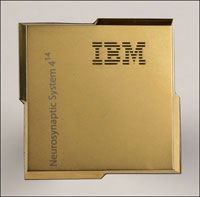
The TrueNorth chip redefines what is possible in the field of brain-inspired computers, in terms of size, architecture, efficiency, scalability, and design techniques.
IBM researchers have developed a “synaptic processor” called TrueNorth with an architecture inspired by the human brain. In a departure from the Von Neumann architecture found in conventional computers, IBM’s brain-inspired system consists of a network of neurosynaptic cores.
- Cores are distributed and operated in parallel. Core operate without a clock in an event-driven fashion.
- Cores integrate memory, computation, and communication. Individual cores can fail and yet, like the brain, the architecture can still function.
- Cores on the same chip communicate with one another via an on-chip event-driven network.
- Chips communicate via an inter-chip interface leading to seamless scalability like the cortex, enabling creation of scalable neuromorphic systems.
According to IBM, TrueNorth is the culmination of almost a decade of research and development, and is a huge leap forward from the initial single-core hardware prototype developed in 2011.
Let’s be clear: we have not built the brain, or any brain. We have built a computer that is inspired by the brain. The inputs to and outputs of this computer are spikes. Functionally, it transforms a spatio-temporal stream of input spikes into a spatio-temporal stream of output spikes. If one were to measure activities of 1 million neurons in TrueNorth, one would see something akin to a night cityscape with blinking lights. Given this unconventional computing paradigm, compiling C++ to TrueNorth is like using a hammer for a screw. As a result, to harness TrueNorth, we have designed an end-to-end ecosystem complete with a new simulator, a new programming language, an integrated programming environment, new libraries, new (and old) algorithms as well as applications, and a new teaching curriculum (affectionately called, “SyNAPSE University”). The goal of the ecosystem is to dramatically increase programmer productivity. Metaphorically, if TrueNorth is “ENIAC”, then our ecosystem is the corresponding “FORTRAN.”
IBM’s long-term goal is to build a neuro-synaptic chip system with ten billion neurons and one hundred trillion synapses, all while consuming only one kilowatt of power and occupying less than two liters of volume. This technology will be used in many fields that span both research and industry, including public safety, vision assistance for the blind, home health monitoring and transportation.
Read the Full Story.



